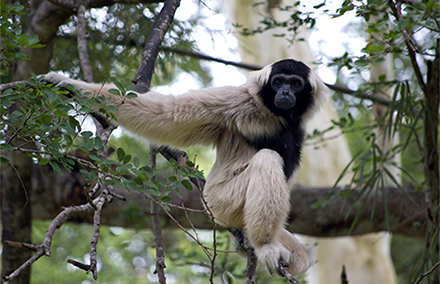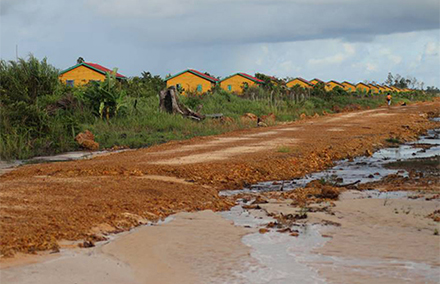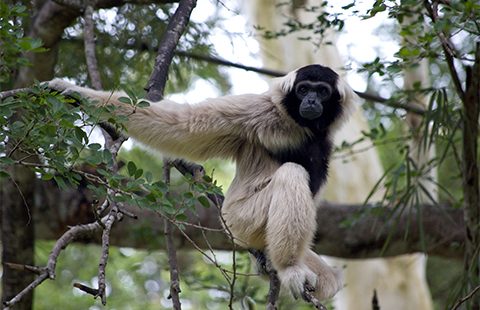
Botum Sakor National Park has a very rich and varied wildlife, some of which is unique to the world. The Pileated Gibbons are just one of eight globally endangered mammalian species found living here. Photo from Wikimedia commons.
Human relocation and Chinese developments threaten the country’s largest national park.
Nestled at the foot of Cambodia’s Cardamom mountain range and stretching to the Gulf of Thailand is Botum Sakor, home to an extraordinary diversity of plant and animal species and the country’s largest national park. But it would seem as though that haven is now under threat; from both development and human relocation.
The 171,250 hectares located in the southwest of Cambodia has been reclassified as state private land and carved up for investment by the Royal Government of Cambodia (RGC).
In May 2008 the RGC granted 36,000 hectares to a Chinese company, Union Development Group, for real estate development. In August 2011, another 9,100 hectares was given to UDG for dam construction.
The US $3.8 billion project will usher in hotels, as well as a casino, resort, commercial centre, airport, satellite city, highway, hospital, schools, port and industrial parks over the next 25 to 30 years. Four other companies have also recently been authorised to access land inside the park.
According to a 2012 UN report, 1,163 families from coastal fishing villages were forcibly evicted to make way for the developments, relocated to resettlement sites deep inside the remnant national park.
Human activity by these relocated communities is also having a negative environmental impact on Botum Sakor. For example, the percentage and distribution of four land cover types – forest, shrub/bush, non-forest land, and water – have changed. But two in particular, forest and non-forest, have changed significantly. Forest area has decreased, and the net area of non-forest land has increased.
I recently studied land use/land cover change in the park over 20 years from 1993 to 2013 to not only track its ongoing degradation, but to assess the fragility of the park as a consequence of human activities after relocation.
My findings show that between 1993 and 2003, forest cover decreased from 117,480 hectares to 107,988 hectares; an annual rate of change of 0.81 per cent. However this sharply decreased between 2003 and 2013 to 84,651 hectares; representing more than a doubling in the annual rate change to 2.16 per cent.
Non-forest land increased significantly from 23,481 hectares in 1993 to 33,473 hectares in 2003 and to 57,201 hectares in 2013. The annual rate of change in non-forest land also differs between those two periods. Between 1993 and 2003 it averaged to 4.26 per cent, almost doubling to 7.09 per cent between 2003 and 2013.
The other two classes, shrub/bush and water, did not significantly differ between these two periods. Shrub/bush slightly decreased in the first period from 1993 to 2003 with an annual rate of change of 0.52 per cent, but recovered a little in the period 2003 to 2013 with an annual rate of change of 0.21 per cent.
Similarly, water started with a sharp increase from 1,624 hectares to 2,606 hectares with an annual rate of change of 6.05 per cent in the first period, but decreased to 1,657 hectares with annual rate of change of 3.64 per cent in the second period.
From these results, it can be seen that intact forest inside the national park was converted into non-forest land for commercial developments, settlements, agricultural land and recreational activities. The conversion accelerated in the period 2003 to 2013 when Cambodia experienced a surge in foreign direct investment.

Some of the housing for relocated locals in Botum Sakor national park. Photo supplied.
Before commercial development inside the national park required their relocation, the more than a thousand families were mainly dependent on coastal fishing. In their original settlements, 65 per cent of the people nominated their primary occupation as fishing, but in the new resettlement sites, the number sharply decreased to 19 per cent.
Once moved to resettlement sites inside the park, relocated communities completely changed their way of life. In particular fishing was replaced by other activities and sources of sustenance, including the collection of non-timber forest products (NTFP) and Timber Forest Products (TFP), and charcoal production.
Non-timber forest products include biological materials derived from forests for human use and as a source of income. Major NTFPs in the region are bamboo and rattan, forest honey, resins and gums, aromatic and medicinal plants, forest fruits and nuts.
Charcoal production is a source of fuel for cooking and heating that many rural and urban people are dependent upon, but when done so unsustainably and illegally contributes to deforestation, desertification, and climate change, as well as to the destruction of habitats of endangered species and other wildlife.
Virtually unknown activities in their home villages, in the resettlement sites 4.8 per cent of people interviewed reported these activities as being income sources.
This figure is small, but it may expand if it is not recognised that the resettled communities require more active assistance. Collection of timber forest product and charcoal production are illegal and prohibited according to Cambodian Forestry Law. However, the export of charcoal has recently increased.
Taken together these three new activities will contribute to greater progressive forest degradation inside the park.
Overall it can be seen that Botum Sakor national park has been steadily degraded for the past 20 years. The trend in depleted forest area has accelerated to a rate of 2.16 per cent in the 10 years between 2003 and 2013 when there many lands were granted to Chinese investors by the government of Cambodia. Land conversion from primary forest to commercial developments has been driven in large part by foreign direct investments. The forest which is a common good was converted by companies investing for private gain.
Furthermore, the forest ecology inside the remnant park continues to be vulnerable due to expanding activities of the resettled communities, whose livelihoods and income were changed along with their circumstances. More forest will inevitably be lost in the future, unless the government together with the companies take responsibility for improving incomes.
Bandos Ros is a master’s student of Hiroshima University, Japan. This article is based on their recent study of land use/land cover change in Botum Sakor National Park.
 Facebook
Facebook  Twitter
Twitter  Soundcloud
Soundcloud  Youtube
Youtube  Rss
Rss 